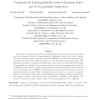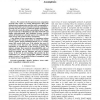35 search results - page 2 / 7 » Trapdoors for Hard Lattices and New Cryptographic Constructi... |
EUROCRYPT
2012
Springer
11 years 8 months ago
2012
Springer
We provide an alternative method for constructing lattice-based digital signatures which does not use the “hash-and-sign” methodology of Gentry, Peikert, and Vaikuntanathan (ST...
EUROCRYPT
2005
Springer
13 years 11 months ago
2005
Springer
We introduce a computational problem of distinguishing between two specific quantum states as a new cryptographic problem to design a quantum cryptographic scheme that is “secu...
STACS
2009
Springer
14 years 10 days ago
2009
Springer
We revisit the problem of generating a “hard” random lattice together with a basis of relatively short vectors. This problem has gained in importance lately due to new cryptogr...
FOCS
2010
IEEE
13 years 3 months ago
2010
IEEE
We construct the first general secure computation protocols that require no trusted infrastructure other than authenticated communication, and that satisfy a meaningful notion of s...
STOC
2005
ACM
14 years 5 months ago
2005
ACM
We present a new constant round protocol for non-malleable zero-knowledge. Using this protocol as a subroutine, we obtain a new constant-round protocol for non-malleable commitmen...


